Menu
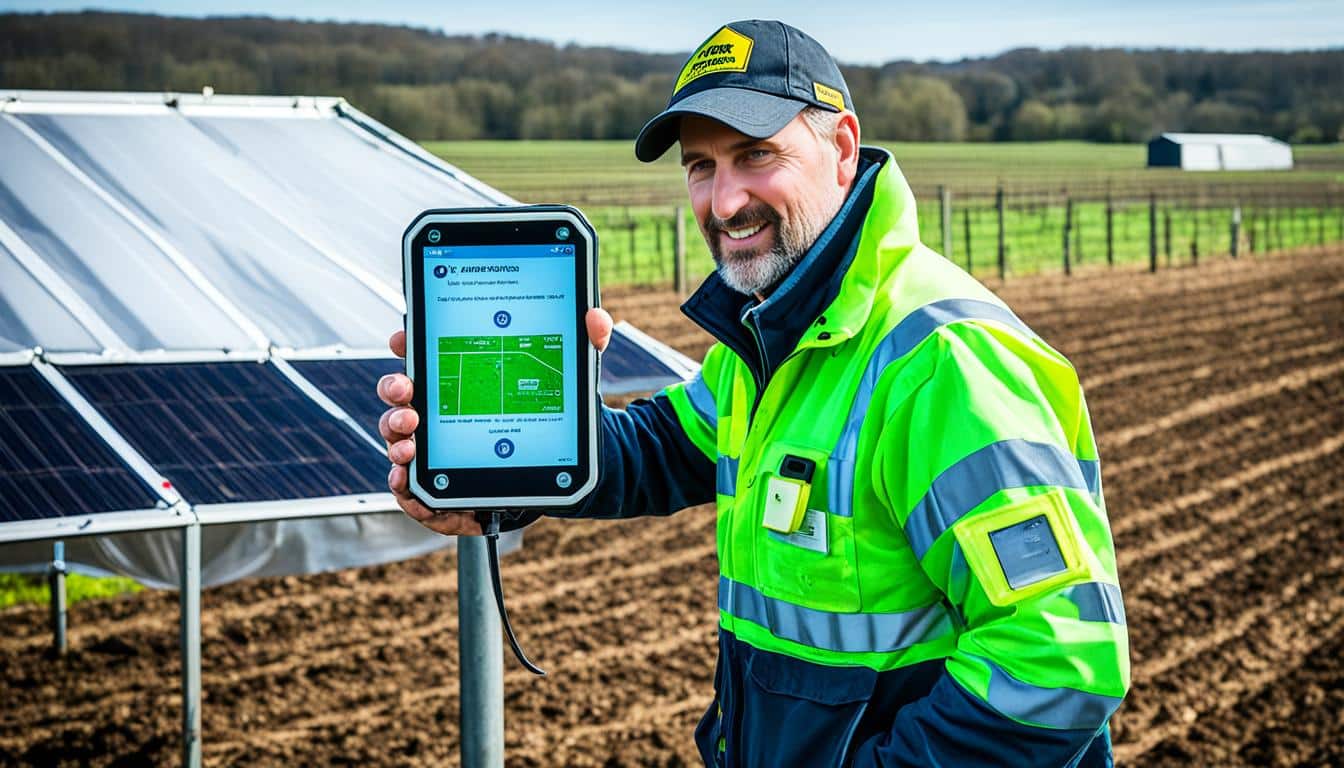
Every day, about 100 farm workers get injured, needing time off work. This high number shows why we need digital tools to make farms safer. As a journalist, I focus on how these tools are vital in farming. They help with health and managing risks as farming changes.
New tech like special tools and devices is making farm work easier on the body. Dr. Aaron Yoder says they’ve improved 75% of tasks. Websites like AgrAbility’s Assistive Technology and New Technologies for Ag Extension, and apps for safety, play a big role.
Farmers can find lots of help, from money to ergonomic changes and tips on how to avoid risks using data. These digital improvements are key for making farm life less risky and more enjoyable. They also help keep minds healthy and work more smoothly.
Farm safety is crucial in today’s agriculture. Workers can face danger from many sources. These include problems with tools, exposure to chemicals, risky animals, and weather changes due to climate change. Sadly, in the U.S. alone, 146 people died because of tractors in 2018. This shows how important safety apps, farm security software, and safety management are.
Accidents with big machinery, contact with harmful chemicals, bites from animals, and bad weather are all common dangers. It’s vital to regularly check for risks on a farm and have plans to stay safe.
Wearing the right clothes and using the correct gear is very important. This includes things like long sleeves, gloves, steel-capped boots, and masks for working with chemicals. Alongside proper training, this gear helps create a safe working environment.
According to the NIOSH, about 100 farm workers are injured every day in a way that keeps them from working. This highlights how much we need to focus on safety tools and apps to keep people safe.
Many countries enforce safety laws for farms, like the U.S., UK, Australia, and the EU. These laws aim to reduce risks and control the use of harmful chemicals. Also, new farming tech can make safety better, with tools like IoT helping to track dangers in real-time and manage risks automatically.
Today, on-board tech is key in making agriculture safer. With cutting-edge digital tools in our machines, the dangers of farming are going down. A major step forward is the introduction of Data Screen Managers.

Modern agricultural safety technology has brought about a big change. Data Screen Managers are making tractor use safer by simplifying how they work. They use easy-to-read displays to give constant updates on key info. This keeps operators up to speed on their actions, leading to safer habits and better overall farm safety.
Instant feedback from these tech tools is vital for better farming safety. The Data Screen Manager checks vehicle status 24/7. It flags when something needs fixing, stopping problems before they start. By teaming new tech with the old ways of farming, we’re making farm work less risky.
Innovation in thermal drones is cutting down human contact with risky farm areas. These digital tools help farmers monitor livestock from afar. They can also manage chemicals in fields, making it safer for farmers.
Over 50% of farmers over 50 years old have lost hearing due to farm noise. To lower this risk, drones with special cameras watch over livestock. They detect early signs of plant problems to help treat them fast. For example, the DJI Matrice 300 RTK drone with Zenmuse H20T can cover a wide area. It gives farmers up-to-the-minute data to look after their animals.
Drones use systems that spray chemicals precisely, reducing the amount used. Drones with thermal cameras and sensors spot pests early. This helps protect good insects. The Autel EVO II Dual 640T V2, for instance, can fly to tough spots. It makes sure the correct amount of pesticides is used safely.
Using drones and apps makes farming more efficient and safer. These tools help track animals and manage chemicals. Farmers can take care of business while making sure to protect the environment and their health.
| Drone Model | Flight Time | Range | Special Features |
|---|---|---|---|
| DJI Matrice 300 RTK | 55 minutes | 15 km | Thermal imaging, multispectral sensors |
| JOUAV CW-30E | Up to 8 hours | 200 km | Large-area surveillance, high-speed |
| Autel EVO II Dual 640T V2 | 38 minutes | N/A | Wind resistance class 8, 360-degree obstacle avoidance |
Remote sensing technology is making farms safer. It focuses on preventing accidents in grain bins, which are very risky. Now, farmers can keep an eye on their grain bins from afar. This means they don’t have to go into the dangerous bins often.
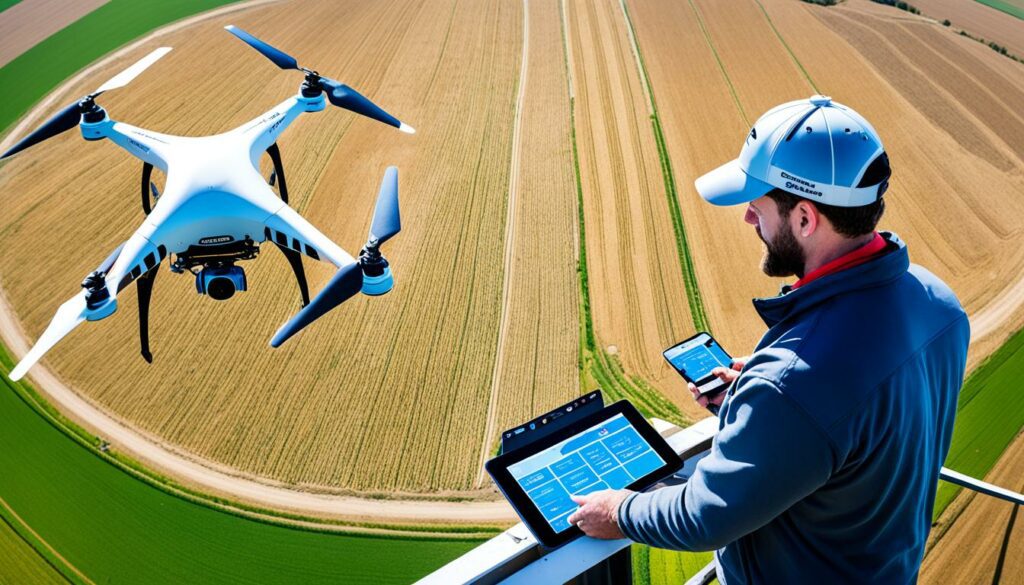
These high-tech tools help farmers check the grain’s temperature and dampness levels using their phones. This prevents accidents and keeps the grain in good condition. Devices like agricultural sensors and GPS trackers are part of this safety system. They help save resources and make farming more productive.
Wireless systems in grain bins are a big step forward in farm safety. They use LoRaWAN® and Cellular IoT to connect globally. These systems are tough, built to last in tough farming conditions.
These smart systems also let farmers set alerts. For example, they can get reminders for when to do maintenance. This keeps the grain healthy and the farm safe. It shows how modern farming is using smart tools to be safer and more effective.
Farm MAPPER is a key tool for better emergency responses in agriculture. This tool is online and can be used on any device. It gives emergency teams all the details they need about dangers, places, and layouts on farms.
How data is seen and shared is super important, especially in tough times. Farm MAPPER works on any device easily. It lets responders quickly see details of farms from above, which is vital for safe and quick reactions to dangers.
Getting updates live is a massive help when there’s an emergency on a farm. Responders often rush to areas far from hospitals. Quick, smart action is key. By using Farm MAPPER, they can spot dangers fast and choose the best actions, improving health and safety in the countryside.
From 2016 to 2022, Farm MAPPER’s project trained many emergency workers and got lots of praise. Now, over 70 experts can teach others, and 20 new learners joined in Wisconsin, Vermont, and Ohio. It shows this tool is a real solution, not just a plan on paper.
This tool’s success has reached far and wide, even being praised in Canada’s Western Producer magazine. Besides online, it also spreads its message through brochures and more. This keeps everyone, from farmers to emergency teams, in the know about staying safe and responding well.
| Year | Key Milestones | Impact |
|---|---|---|
| 2013 | Initial media coverage with significant viewership | 120 million unique visitors |
| 2016-2022 | Project duration with widespread training | Over 70 firefighters/EMS trained as trainers |
| 2022 | Expanded training programmes | 20 new participants joined from multiple states |
To sum up, Farm MAPPER is changing the game in farming safety with its easy, up-to-date info. It’s showing the fundamental role of technology in making farming safer today.
The integration of ergonomic technology and wearables for farming improves farm safety. Smart devices help reduce the hard work farmers face. This boost in productivity and health makes a big difference.
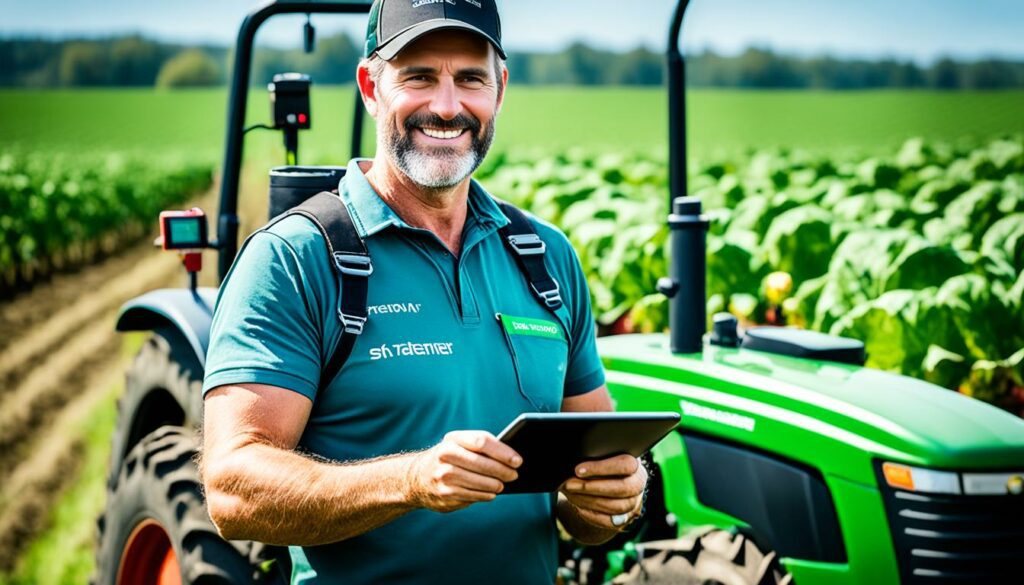
Ergonomic tools are key for safe and healthy farming. They are crafted to meet the challenges of farm work. These tools help avoid injuries related to strain and too much effort. They make the farm a safer place to work.
Wearable gadgets are making farms safer by watching over worker health. They keep an eye on important signs like heart rate. This gives early alerts, cutting down on health risks. Farm wearables promote good health, keeping both body and mind well in a tough job.
The farming industry is always changing, using technology to become more efficient and safe. A new development is using fitness trackers, much like FitBits, for cows. Leading companies, StellApps and QuantifiedAg, have made devices that keep track of a cow’s heartbeat, steps, and habits. This helps manage cow health and makes farming safer for workers.
Keeping an eye on a cow’s health and activities is crucial for farming today. Farmers can now see real-time data about their cow’s health, allowing them to act quickly and avoid problems. These digital tools keep cows safe, leading to better farm output.
With these new tools, farmers are better prepared to look after their cows. The trackers show detailed information about what cows do each day and their health. This helps avoid dangers. Also, healthy cows mean less waste, lower costs, and fewer harmful gases for the planet.
Below is a detailed comparison showcasing key statistics and advancements in farm safety and livestock health management:
| Key Aspects | Data |
|---|---|
| Workplace Deaths in Agriculture 2018 (Wisconsin) | 25% |
| Daily Injuries with Lost Work Time (US) | 100 farm workers |
| Leading Cause of Death | Tractor accidents |
| Grain Bin Entrapment in the Midwest | 83% |
| Halter: Hours Saved per Week | 30 hours |
Using fitness trackers for cows is a great example of how technology can change farming. It provides a complete way to manage livestock by watching their health closely. This makes farming both safer and more efficient.
Today, cell phones are vital tools on modern farms. They keep farmers in touch and make farms safer.
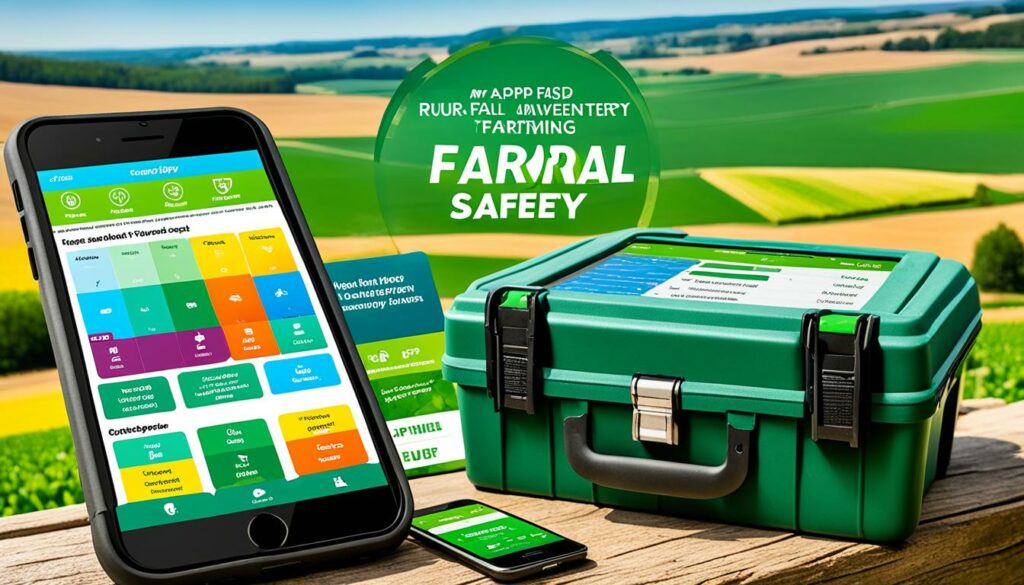
Modern phones use geotagging for fast emergency help. This is key for farm security. It ensures help goes straight to where it’s most needed quickly.
Good communication is crucial on big farm lands. Phones help share info easily, making all farm areas work together.
This steady connection is vital for daily work and emergencies. Using data and AI makes communication even better. This avoids delays and ensures quick help when needed.
Farms are now using smart technology to keep operators safe. This tech makes sure that farm machines are looking out for the people using them. By sharing where they are in real time, these machines help quickly in an emergency and make work more efficient.
Modern farming relies heavily on telematics for safety. It sends out location data so we know where every person and machine is. This means in emergencies, help can get there much faster, saving lives.
Telematics also sends alerts to help operators avoid common risks. With GPS, it warns about dangers in the land, making the farm a safer place to work.
Keeping an eye on machinery from afar is key today. It lets farmers see how the equipment is doing and if it needs fixing. This helps avoid big problems and keeps the farm running smoothly and safely.
John Deere’s AutoTrac™ system is one such tool. It reduces the stress of making constant decisions and the tiredness that comes with farming. These tools boost efficiency and safety on the farm.
By using these digital tools and software, farms are safer than ever. They keep everyone and everything working well and reduce the chance of accidents.
Automation doesn’t just reduce physical in the farming sector. It also has big benefits for mental health. Research shows that farmers face a lot of stress from making too many decisions. This can raise the stress hormone, cortisol. But, by using new tech and equipment, farmers can lessen this mental load.
Technologies like auto-trac and turn automation help ease decision-making. They allow for work on the field with less mental stress. This also stops quick, possibly risky decisions. So, work is not just safer but also more efficient.
Not missing out on maintenance is key too. It helps spot potential issues before they become real problems. This prevent unexpected stops and the stress that comes with them. This is a big part of keeping farming operations running smoothly.
Getting real-time data is also vital in keeping stress under control. By knowing things like costs, field space, and the weather, decisions can be better. This leads to a more organized and less stressful working environment.
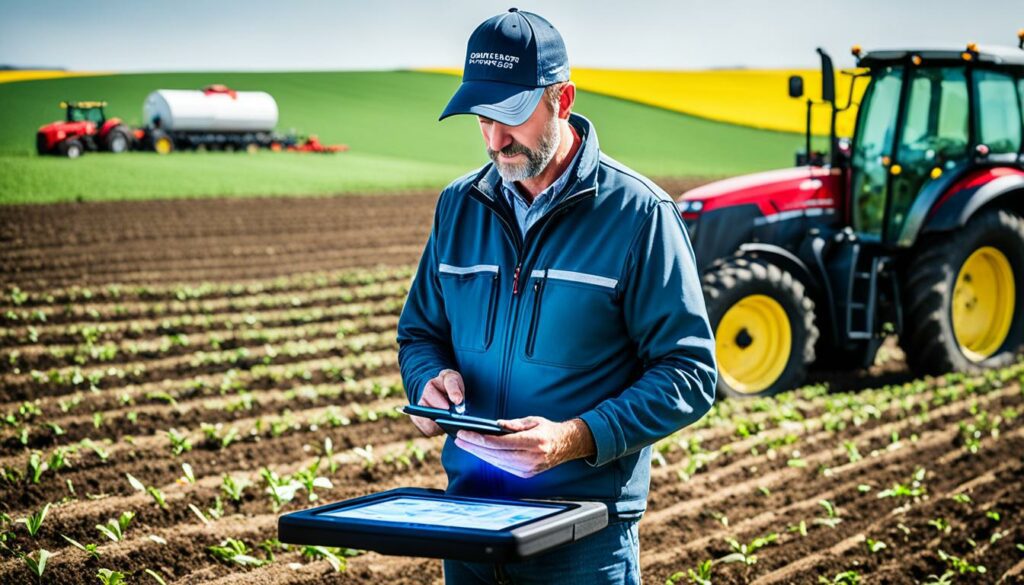
Valtra tractors are a great example of how tech can make farming safer. Their latest models have high bonnets for better vision, reducing accidents. The AI-powered Unlimited VIEW system with cameras cuts down on blind spot accidents.
Valtra’s AIRES suspension system makes the ride more comfortable, even in bad weather. This cuts down on fatigue and back pain. Valtra’s smart tech boosts efficiency and reduces stress, allowing farmers to focus on what matters most.
Valtra Connect changes the game by making tractor data always accessible. This boosts productivity by keeping tractors up and running. Solutions like Valtra Guide and Auto U-Pilot simplify steering, reducing the mental burden during turns.
Valtra’s Section Control and Variable Rate Control tech make sure product application is exact. This means less stress and waste. Streamlining data collection with TaskDoc Pro saves time, letting farmers relax or do more valuable tasks.
By using the best in *farming hazard prevention tools* and *agricultural risk management*, automation enhances both physical and mental health. It creates a safer, more effective farming setting. And it puts the well-being of farmers first, as it should.
Ergonomic technology in farming makes a big difference. It makes work easier and safer. Many farm workers hurt their bodies because of tasks like lifting heavy things over and over. Ergonomic tools change this. They cut down on the hard physical work. This makes the farm a safer place to be.
There are laws that protect workers in Italy, like the Legislative Decree 81/08. These laws make sure that farms are safe places to work. Tools with ergonomic features help a lot. For example, long-handled hoes help farmers work without bending their backs too much. This not only makes the work faster but also keeps the farmers healthier.
Adjusting tools to fit each farm worker makes a big difference. The length of the handles, how wide they are, and their weight can all be changed. This helps reduce back pain and knee problems which are common on farms. A 2018 study by Caffaro et al. showed that training plus the right tools made migrant farm workers much safer.
| Solution | Impact |
|---|---|
| Long-handled hoes | Reduced trunk flexion, increased productivity |
| Customised tool handles | Decreased repetitive strain injuries |
| Pneumatically-powered cutters | Enabled workers with partial disabilities to perform tasks |
| Smaller tubs for grape harvesting | Reduced physical strain from carrying heavy loads |
Ergonomic tools show a commitment to making farming safer and more sustainable. They help create a better working environment for those in agriculture.
Modern communication systems are changing how farms work together. They make things more efficient and safer. Agricultural safety technology and farm safety digital tools are vital now.
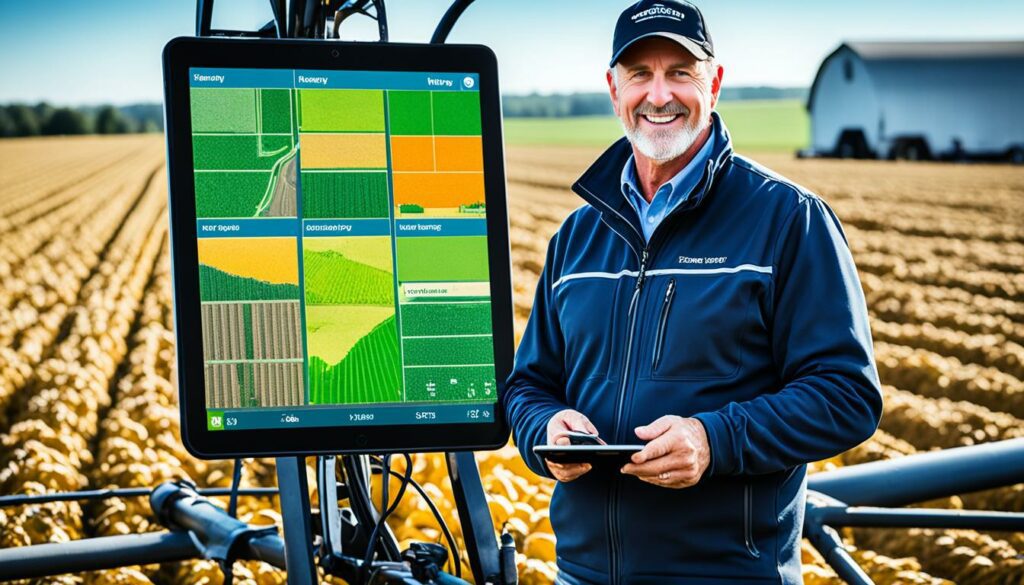
One big benefit is sharing data immediately. This means quick access to crop, livestock, and machine info. And when everyone knows what’s happening, it’s easier to make fast decisions.
Quick decisions help avoid dangers and make the farm safer.
Farm safety digital tools help workers coordinate better. They use IoT and instant messaging. This lets them share updates quickly, change strategies, and react fast to new situations. Working together well makes the farm both safer and more streamlined.
These new systems are making farming smarter, safer, and more collaborative. They’re a big part of how farming is changing today.
The farm world is not very digital. Now, it’s changing fast with new digital tools for safety. These tools help make farms safer and more sustainable. They’re known as rural health and safety software and digital farm safety resources.
Robots in farming are now worth over $5 billion. This value is expected to grow a lot in the next five years. Digital devices used in farming, like those connected to the internet (IoT), are now over $11.4 billion.
Thanks to digital tech, we can collect a lot of data. By 2025, this could be 175 zettabytes of data. This data helps make farming smarter and kinder to the earth. It allows farms to be managed carefully, improving how things are grown and lowering harm to the environment.
Precision tools and small robots are changing how farms work. They do jobs like watering precisely and weeding by themselves. This means fewer people are needed to work the land. And less harmful chemicals are used. Farming becomes smarter and better for nature with these new gadgets.
Drones are changing farming in big ways, too. In China, they watch over cotton fields across 20 million hectares. They make farming safer by doing jobs people used to do in dangerous places. This high-tech watch is a big step forward in keeping farms running well.
| Technology | Market Value | Usage | Efficiency Gain |
|---|---|---|---|
| Robotics | $5 Billion | Doubling in 5 years | Labour Shortage Resolution |
| IoT Devices | $11.4 Billion | Data Management | Improved Resource Allocation |
| Drones | NA | 20 Million Hectares | Enhanced Surveillance |
Being slow to use digital tools could really hurt our food supply. University of Illinois scientists are working on ways to get more farmers to use tech. They’re doing research to show how tech can make farming better and kinder to nature.
In the end, turning to rural health and safety software and digital farm safety resources is crucial. It helps move farm safety from being just about reacting to being about preventing harm. This keeps farmers safe and makes sure farms worldwide can keep growing food in a good way for the earth.
Studying how agriculture tech improves safety shows the big change it makes on farms. These studies share real stories that prove how well these techs work.
Farmers in the Midwest are using rural safety apps for cattle health. These apps make work smoother and keep the area safe. They alert farmers if the cattle get sick, lowering deaths and boosting work output.

Using safety tech in farming teaches us some top methods. For example, farmers in Europe have started using RFID tech for equipment checks. This change has seen a 15% drop in injuries. Now, fixing stuff is quicker because of live updates.
| Technology | Region | Benefits |
|---|---|---|
| Rural Safety Apps | Midwest, USA | Real-time health alerts, reduced animal mortality |
| RFID Technology | Europe | Enhanced monitoring, 15% reduction in injuries |
| Farm Management Software | North America | Improved planning, real-time data |
Adopting these digital tools shows how crucial they are in today’s farming. From basic safety apps to advanced tracking, they lead to better, safer farms.
New technologies are changing how we keep farms safe. They promise to make farming safer and more efficient. This means big changes are on the way for the agricultural world.
Autonomous farming is going to completely change how we see farming. It will boost efficiency and productivity with its ability to work around the clock. This tech makes farming cheaper by cutting out the need to hire workers. It also makes harvests better by using precise methods.
But that’s not all. It also helps the environment by using fewer harmful chemicals and using water and soil smarter. This helps save natural resources and cuts down on farming’s pollution. For example, automated water systems save water by using it only where it’s needed.
Drones and UAVs are also set to make a huge impact. They can do many things like inspecting crops, spraying, planting, and checking the soil. This boosts how well and how accurately farming is done.
Precision agriculture is combining high tech and data to make farming smarter. This makes it easier to feed more people using fewer resources. It also speeds up harvests without manual work, making it safer for everyone.
Autonomous farming also leads the way in using renewable energy, like from the sun. This cuts down on using fossil fuels, which is better for the planet. These steps help farming be safer and greener.
Protecting the farm with special software is now critical. It helps keep an eye on things in real time, making sure everything runs well. It uses tech like telematics and GPS to keep equipment safe and react fast in emergencies.
By using the latest security tech, farmers can work in better, safer conditions. They’re less exposed to harmful things, and their work becomes more efficient. This shows the future of farming is moving towards safety and productivity.
Looking at how technology changes farming safety, we see big opportunities. Things like rollover protection and advanced tools help lower risks. They make farming both safer and more productive.
Modern tools, from sensors to better communication, are making a real difference. Also, online safety help, like the Farm Safety Foundation’s, are key. They make it easier for farmers to meet safety rules.
Keeping farms safe is everyone’s job. We need to check safety often and teach everyone, no matter what language they speak. With these efforts, we protect those who work on farms. This makes farming not just safer, but also better for everyone.
Farm safety tools are using tech to make farming safer. They include things like ergonomic tech and thermal drones. These help reduce dangers for farmers.
Farm safety matters a lot today. There are many risks in farming, like accidents with machinery. Safety tools, apps, and software are key to keeping workers safe and food supplies secure.
On-board tech gives instant feedback to tractor drivers. It helps them drive safer and keep their machines well-maintained. This lowers the chance of accidents.
Thermal drones check on animals and monitor fields from afar. This keeps farmers away from dangerous chemicals and pesticides. So, they make farming safer.
Remote sensors stop people getting trapped in grain bins. They use wireless tech to check grain quality from a distance. This keeps farmers out of harm’s way.
Farm MAPPER shows detailed farm info to emergency teams. It helps them save lives by knowing where to go quickly. This makes for better and safer farm rescues.
Wearable gadgets help workers move and stay healthy. They reduce strain and keep an eye on health. So, these gadgets help prevent farm injuries.
Wearables for cows let farmers track health and behaviour. It helps give cows better care and keeps them healthy. So, farming is more efficient and the animals are looked after.
Mobiles with GPS can quickly help in emergencies. They also help workers communicate over big areas. This is vital for keeping farms safe and well-managed.
Connected machines keep track of operators and their use. They alert for quick action and predict problems. This makes working with machines safer and more efficient.
Automated farm tech takes off the pressure of making constant decisions. This lessens stress, which is important for farmers’ health. It makes farming more bearable and efficient.
Ergonomic tech is fitting traditional tools to each person’s needs. This makes work safer and easier, cutting down on physical strain and injuries.
Today’s communication links farmers in real time. They help manage the farm better and work as a team. This boosts safety and efficiency on the farm.
Digital tools are making farms notably safer. They focus on health and safety with new software and resources. This change keeps the farm running well and the people safe.
Success stories teach us how to use tech for safety in farming. They show tech makes farming safer and more efficient. This is valuable for all farms.
The future looks bright for farm safety. New tech keeps coming to look after farmers’ health and safety. This progress makes farming a safer and happier place to work.